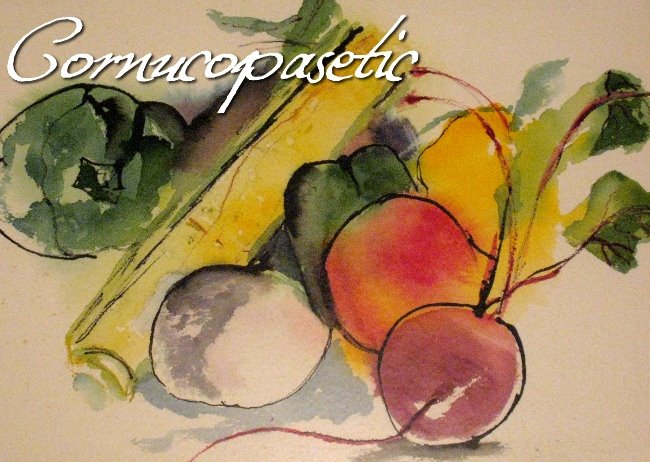My best buddy Tyler and I have been doing the rounds at various Portland area luncheries for some not very cornucopasetic, but very fun, eating. Here are our reviews in haiku.
El Rayo
Cornucopasetic
Rating: 6 jumping green lizards.
Two little tacos
failed to excite my taste buds;
ah, but the refresco.
TylerRating: 5 effervescent cucumber bubbles.
Simple beans and rice
sparkling cucumber cocktail
fusing fares falls flat
Nosh Kitchen BarCornucopaseticRating: 7 bacon dusted fries.
This time it was a
sandwich to tell tales about;
bacon dust fries win.
TylerRating: 9 gusts of freaky cold wind.
Who would have thunk it?
Garlic jam and egg burger
good? You're damn skippy!
Skinny Cart BBQCornucopaseticRating: 8 G-spots.
G-spots, bacon bongs:
Is this really barbecue?
Oh hell yes it is!
TylerRating: 9 wasp's nipples.
Pork chop on a bun
grilled to perfection, quickly
enjoyed on the prom.
Mrs. Muffin & Mr. SandwichCornucopaseticRating: 5 macadamia nut and white chocolate chip cookies.
Bread too thick to eat
Is not so yummy a treat;
thanks for the cookie.
[N.B.
Tyler's friend Breana and her family opened a bakery and sandwich shop on the corner of Congress and Deering. My sandwich was held back by a french roll that was too dense and hard, and by orange american cheese. Some of the other sandwiches I saw there looked a lot better, so give them some custom to help them work the kinks out. As a further aside, Breana and Katie are really beautiful (and they're twins), so—with all due respect to their mother—the picture that was used for the
PPH article is kind of baffling.]
TylerRating: 8 "she's MY friend, jackass"'s.
turkey, pickle, rye
spicy avocado sauce
sandwich nirvana
Po'Boys & PicklesCornucopaseticRating: 7 tablespoons of bacon praline.
Fried oyster Po'Boy
and crazy bacon topping—
this place doesn't play.
[N.B. This refers to when I asked for the hot barbecue sauce at a soul food place in Oakland, California. After the sauce cause smoke to come out of my ears, the waitress said, flatly: "Honey, we don't play."]
TylerRating: 8 used napkins.
sweet potato fries
very jubilant taste buds
I hanker for more
Bogusha's Polish Restaurant and DeliCornucopaseticRating: 5.5 hot pierogis.
The Polish Platter:
Five forms of starchy goodness.
Oh gods, I'm so full.
TylerRating: 7 tins of pork
nice Polish accent
yummy home-cooked Polish food
Brad is a lousy tipper
[C: Am not!]
158 Pickett Street Cafe (f/k/a One Fifty Ate)CornucopaseticRating: 8 cowboy cookies.
In the back clearing
A sandwich epiphany;
Mustard on my shoe.
TylerRating: 9 flat punchlines
five napkin sandwich
loved every minute; still
licking my fingers
Bazkari
CornucopaseticRating: 8 parma hams.
Very special rice.
So very very special.
And a ham sandwich.
[N.B. Building on the street food presence started by Skinny Cart BBQ, Bazkari will soon be bringing "Spain to Maine" from their street cart at the Wednesday Farmers' Market at Monument Square. Her "Very Special Rice" was amazing with bits of prosciutto, egg, shrimp, pork and scallion. The sandwich that day was ham, manchego and a "special sauce" that I couldn't get very much information about. This place is excellent. For now you can catch them on Wednesdays inside the Portland Public Markethouse. Also, if you phone in your order to them in the morning they'll deliver your lunch to you without charging you a delivery cost.]
Stareast CafeCornucopaseticRating: 7 kebabs (pronounced "keh-babbs" like Jamie Oliver or Hugh Fearnley-Whittingstall would pronounce it).
Lamb kabob, rice and
samoor baked in a tandoor;
I love cardamon.
[N.B. This place got robbed by Nancy English's
review a few years back. The rice served with the kabobs is really excellent—basmati with small threads of vermicelli that have been fried with cardamon and tumeric. He sprinkles ground sumac over the lamb kabob. The lamb is tender. The bread is baked in a tandoor to order, so you get it still crispy and hot and the hummus sort of melts into it. Why don't we hear more about this place on the food blogs? Sure the decor isn't much, but so what.]
Taste of TampaCornucopaseticRating: 6.5 conch fritters, in transit from the Bahamas.
Manly ham sandwich
produced amidst purses
and dresses: still good.
[N.B. This place had a soft opening today. The interior is pretty crazy. I wasn't really sure they actually offered food until I found my way to the back past all the purses and clothes and giant, fake plants dominating the several central tables that each, oddly enough, have just one chair. Today they only had their cubana sandwich and a pulled pork sandwich. I know there's a whole cult following for the cubana sandwich and that it's supposedly impossible to get one made correctly outside of Miami or whatever—I've never had the real deal so I don't know the difference—but this sandwich was pretty good: crispy on the outside, not unmanageably large, nice sauce, although it could maybe use some better ham. Starting next week they'll have conch fritters, bean fritters, corn fritters, crab empanadas, fig empanadas, and a whole bunch of other stuff. I'd suggest getting it to go and eating it in some nice, sunny place.]
 [Photo by Corey Templeton]
[Photo by Corey Templeton]









































